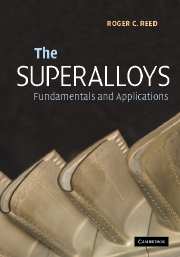Book contents
- Frontmatter
- Contents
- Foreword by Dr Mike Hicks
- Preface
- Acknowledgements
- 1 Introduction
- 2 The physical metallurgy of nickel and its alloys
- 3 Single-crystal superalloys for blade applications
- 4 Superalloys for turbine disc applications
- 5 Environmental degradation: the role of coatings
- 6 Summary and future trends
- Index
4 - Superalloys for turbine disc applications
Published online by Cambridge University Press: 01 September 2009
- Frontmatter
- Contents
- Foreword by Dr Mike Hicks
- Preface
- Acknowledgements
- 1 Introduction
- 2 The physical metallurgy of nickel and its alloys
- 3 Single-crystal superalloys for blade applications
- 4 Superalloys for turbine disc applications
- 5 Environmental degradation: the role of coatings
- 6 Summary and future trends
- Index
Summary
The turbine discs are amongst the most critical of components in the aeroengine. To put this into perspective, consider a typical modern civil turbofan such as the Trent 800 – the turbine discs represent about 20% of its total weight and their cost accounts for about 10% of the engine's value upon entry into service. For a military engine, such as the EJ200, the figures are nearer 5% and 25%. The primary function of the turbine discs is to provide fixturing for the turbine blades located in the gas stream, from which mechanical energy is extracted; the complete assembly of discs and blades is then capable of transmitting power to the fan and compressor sections, via the shafts which run along almost the complete length of the engine. During the design stages, their geometry must be optimised by balancing the competing demands of minimisation of weight, dimensional stability and mechanical integrity. Thus risk mitigation by an appropriate disc lifing strategy is vital, since a disc failure represents a potentially fatal hazard to the aircraft and its occupants. Metallurgical damage due to fatigue during service and its acceleration due to oxidation and/or corrosion must therefore be quantified and predicted, so that each disc is withdrawn from service after a prescribed number of take-off/landing cycles, known as the safe working life.
To convince oneself of the properties required of a turbine disc alloy, it is instructive to consider the operating conditions experienced by a typical high-pressure (HP) turbine disc.
- Type
- Chapter
- Information
- The SuperalloysFundamentals and Applications, pp. 217 - 282Publisher: Cambridge University PressPrint publication year: 2006
- 6
- Cited by



